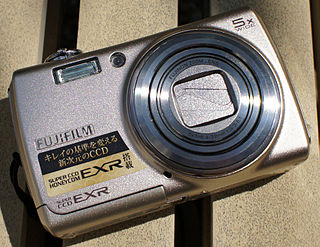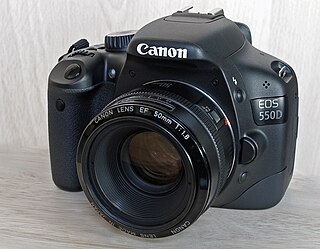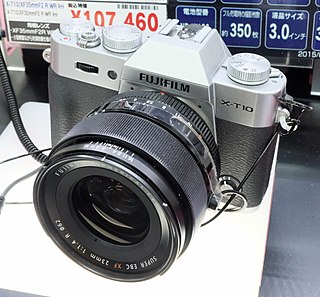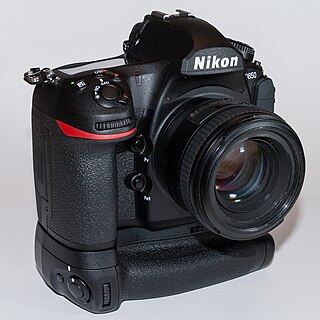
The Nikon D2H is a professional-grade digital single-lens reflex camera introduced by Nikon Corporation on July 22, 2003. It uses Nikon's own JFET-LBCAST sensor with a 4.1-megapixel resolution, and is optimised for sports and action shooting that require a high frame rate. In 2005, the D2H was replaced by the D2Hs, which added new features derived from the 12-megapixel D2X digital SLR. The D2Hs was discontinued after the introduction of the D300 and D3 models.

The FujifilmFinePix F series is a line of compact digital cameras that was known for its low-light performance in 2005, with relatively low image noise and natural colors even at high ISO settings. With its relatively large, but moderate resolution Super CCD sensors, it concentrated on image quality, and low-light shooting without flash, which was mostly restricted to prosumer models at the time.

The Nikon D300 is a 12.3-megapixel semi-professional DX format digital single-lens reflex camera that Nikon Corporation announced on 23 August 2007 along with the Nikon D3 FX format camera. The D300 was discontinued by Nikon on September 11, 2009, being replaced by the modified Nikon D300S, which was released July 30, 2009. The D300S remained the premier Nikon DX camera until the D7100 was released in early 2013.

The Pentax K20D and its clone, the Samsung GX-20, are 14.6 megapixel digital single-lens reflex cameras manufactured by Pentax that were announced on January 23, 2008. The K20D was available in the U.S. market from February 2008 through autumn 2009.

The Nikon D700 is a professional-grade full-frame digital single-lens reflex camera introduced by the Nikon Corporation in July 2008 and manufactured in Japan. It uses the same 12.1-megapixel "FX" CMOS image sensor as the Nikon D3, and is Nikon's second full-frame digital SLR camera.

The Canon EOS 50D is a 15.1-megapixel digital single-lens reflex camera. It is part of the Canon EOS line of cameras, succeeding the EOS 40D and preceding the EOS 60D.

The D5000 is a 12.3-megapixel DX-format DSLR Nikon F-mount camera, announced by Nikon on 14 April 2009. The D5000 has many features in common with the D90. It features a 2.7-inch 230,000-dot resolution tilt-and-swivel LCD monitor, live view, ISO 200–3200, 3D tracking Multi-CAM1000 11-point AF system, active D-Lighting system and automatic correction of lateral chromatic aberration. The D5000 seems to have been discontinued in November 2010.

The Nikon D3000 is a 10.2-megapixel DX format DSLR Nikon F-mount camera announced by Nikon on 30 July 2009. It replaces the D40 as Nikon's entry level DSLR. It features a 3.0-inch 230,000-dot resolution LCD monitor, CCD sensor with ISO 100–1600 and 3D tracking Multi-CAM1000 11-point AF system which makes it quite similar to the Nikon D200 in these main parts. Initially priced with $599 MSRP, actual prices are much lower.

The Nikon D300S is a 12.3-megapixel DX format digital single-lens reflex camera (DSLR) announced by Nikon on 30 July 2009. It replaced the D300 as Nikon's flagship DX format DSLR adding HD video recording. It has some similarities to the Nikon D700, with the same resolution, but has a smaller, higher-density sensor. The D300s was superseded by the Nikon D500, announced on January 5, 2016.

The Canon EOS 550D is an 18.0-megapixel digital single-lens reflex camera, announced by Canon on 8 February 2010. It was available since 24 February 2010, and to US dealers from early March. It is known as the EOS Kiss X4 in Japan, and as the EOS Rebel T2i in the Americas. It is part of Canon's entry- / mid-level digital SLR camera series, and was the successor model to the EOS 500D. It was succeeded by the EOS 600D but remained in Canon's lineup until being discontinued in June 2012 with the announcement of the EOS 650D.

The Nikon D5100 is a 16.2-megapixel DX-format DSLR F-mount camera announced by Nikon on April 5, 2011. It features the same 16.2-megapixel CMOS sensor as the D7000 with 14-bit depth, while delivering Full HD 1080p video mode at either 24, 25 or 30 fps. The D5100 is the first Nikon DSLR to offer 1080p video at a choice of frame rates; previous Nikon DSLRs that recorded 1080p only did so at 24 fps. It replaced the D5000 and was replaced by the D5200.

The Nikon 1 series is a discontinued camera line from Nikon, originally announced on 21 September 2011. The cameras utilized Nikon 1-mount lenses, and featured 1" CX format sensors.

The Nikon D5200 is an F-mount DSLR camera with a newly developed 24.1-megapixel DX-format CMOS image sensor first announced by Nikon on November 6, 2012 for most of the world and January 7, 2013 for the North American market.

The Nikon D7100 is a 24.1-megapixel digital single-lens reflex camera model announced by Nikon in February 2013. It is a 'prosumer' model that replaces the Nikon D7000 as Nikon's flagship DX-format camera, fitting between the company's entry-level and professional DSLR models. This camera is the first ever from Nikon with no optical low-pass filter incorporated. At launch, Nikon gave the D7100 estimated selling price in the United States as US$ 949.95 for the body.

The Ricoh GR is a digital large sensor compact camera announced by Ricoh on April 17, 2013, one of a number of Ricoh GR digital cameras. It was succeeded by the Ricoh GR II in 2015, the Ricoh GR III in 2019, and the GR IIIx in 2021.

The Nikon D750 is a full-frame DSLR camera announced by Nikon on September 12, 2014. It is an extensive upgrade from the D610, but with the same general body and control characteristics, along with 24 megapixel resolution. Despite the 7, there is little relationship with the D700, which was the precursor to the D800. The D600 and D610 evolved as a full-frame consumer cameras with similar structure and controls to the D7000 series of cropped frame cameras. The D750 shares similar structure and controls with the cropped-frame D7500.

The Fujifilm X-T10 is a digital interchangeable-lens camera announced by Fujifilm on May 18, 2015. It is a smaller, lighter and lower priced alternative to the Fujifilm X-T1, Fujifilm's flagship camera. The camera was made available in an all black colour scheme, in addition to a silver and black colour scheme.

The Pentax KP is a 24 megapixel compact APS-C AA-filterless digital SLR camera announced by Ricoh on January 25, 2017. It features a PRIME IV image processor with an "image accelerator unit" that supports its operation up to ISO 819,200. It has a 1/6000s conventional and 1/24,000s electronic shutter. In terms of bracketing modes, it adds depth of field and shutter speed bracketing. The Pentax KP uses the Pentax K-mount interchangeable lens system.

The Nikon D850 is a professional-grade full-frame digital single-lens reflex camera (DSLR) produced by Nikon. The camera was officially announced on July 25, 2017, launched on August 24, 2017, and first shipped on September 8, 2017. Nikon announced it could not fill the preorders on August 28, 2017 and filled less than 10% of preorders on the first shipping day. It is the successor to the Nikon D810.

The Nikon Z6 is a full-frame mirrorless interchangeable-lens camera produced by Nikon. The camera was officially announced on August 23, 2018, to be released in November. Nikon began shipping the Z6 to retailers on November 16, 2018. This was the second camera to use Nikon's new Z-mount system after the release of the 45.75 megapixel Nikon Z 7 in September 2018.




















